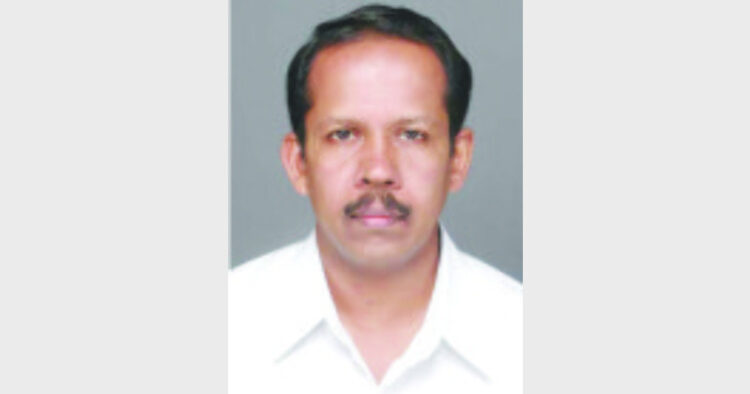A basic tool to protect workers” rights
CK Saji Narayanan, All India President BMS
 THE article by Shri MV Kamath titled “Strike: A self-defeating trade union technique” in issue dated 29-07-2012 of Organiser is thought provoking at the same time debatable on an issue of national importance. If the inconvenience caused to the “hi-fi flying elites” because of the Air India Pilot’s strike, is the reason that has provoked the writer to say ‘strike is unacceptable’, he has to turn his eyes and ears to the floor level realities and the crying needs of our nation.
THE article by Shri MV Kamath titled “Strike: A self-defeating trade union technique” in issue dated 29-07-2012 of Organiser is thought provoking at the same time debatable on an issue of national importance. If the inconvenience caused to the “hi-fi flying elites” because of the Air India Pilot’s strike, is the reason that has provoked the writer to say ‘strike is unacceptable’, he has to turn his eyes and ears to the floor level realities and the crying needs of our nation.
India has a working population of nearly 48 crore. Workers along with their families constitute about ninety per cent of India’s population. We can safely say that working population is the real India or the interest of workers is the nearest equivalent of national interest. Hence the issue of strike related to workers cannot be lightly debated ignoring the social dynamics involved.
We have a long tradition and history of tripartite mechanism functioning to strive for industrial peace. This works closely with ILO which is the most effective tripartite mechanism functioning at the international level. The social dynamics involved in the issue of strike has been gone in detail by these tripartite bodies. In spite of its limitations they were able to achieve industrial peace to a wider extend.
The first reference to strike in the annals of history is in Rig Veda; the victorious strike was conducted by none other than the great Agni. Then Varuna acted as mediator and established the right of Agni (Rig Veda 10.52). Behind legislating innumerable labour laws and establishing workers’ rights, there is a long history of workers’ struggle and strikes. In the present globalised society, where lakhs of people are thrown out of jobs and the labour issues are getting more and more complex, this issue assumes importance.
In the long history of Indian trade union movement,there were great leaders and social reformers of the nation associated with it. From the time of Mahatma Gandhi, strike was used as an effective means for establishing workers’ rights. Gandhiji can be said to be first among the leaders who had successfully conducted strike, in the textile mills of Ahmedabad. He had also successfully fought for the Indian workers in South Africa and against the exploitation of the indigo cultivators of Champaran village by the zamindars.
Today the basic right to strike emanates from the basic labour law of the country, the Industrial Disputes Act, 1947. Provisions of Standing Orders also apply.In Industrial Disputes Act, 1947, strike is defined in Sc.2 (q) as a ‘cessation or refusal of work’. Only a strike which is against Sc.22 (In public utility services) & Sc.23 (During pendency of certain proceedings) of ID Act is illegal. Quoting Mahatma Gandhi’s view on workers’ right to strike as appeared in Harijan, Justice VR Krishna Iyer in his inimitable vocabulary had paid sermon on the “workers’ right to strike as a weapon”in Gujarat Steel Tubes case in Supreme Court (1980).Supreme Court said “right to strike is integral to collective bargaining”. Unfortunately later the Supreme Court verdict in the case of Tamil Nadu Government Employees’ strike, that Government servants have no right to strike is fundamentally wrong. The passing reference on workers other than Government employees is not legally binding on the worker community of the country as Central trade unions were not heard on the matter. Supreme Court ought to have sought the opinion of the recognised Central trade unions,the tripartite bodies functioning in the country and shared the long experience of international bodies like ILO before passing its far reaching and casual remarks on such a subject. Review petitions on it filed are still pending, waiting for the Supreme Court to allot time for this issue. BMS also has filed impleading application.
In countries like Japan where employers show a high level of work culture strike is almost a superfluidity. There token protests by workers are heavily honoured and conscientious employers show high moral level.Many a times it is said that in Japan, workers rarely resort to strike and this attitude of workers is a part of their work culture. But those who propagate this idea conveniently hide the fact that the same work culture includes the high level of the attitude of the employer as well. It is an ordinary experience of Japanese society that whenever due to some reason or other the worker carries a black badge on his dress, even the top executive of the establishment will come down and asks him about his problem. So a beautiful blending of these two faces of the work culture only can result in a healthy industrial culture. Unfortunately that is miserably lacking in our country. During the Kerala Government employees strike few years back, only after nearly one month of strike Government was ready for even to talk to the striking employees, that also under heavy public pressure. How can such Government be given the power to prohibit strike? For that, change in mind set or attitude of the management is required.
Workers can think of discarding strike altogether as a means of redressal, only if there is an “self-restrictive, alternate and effective redressal mechanism”; until which is evolved, strike has to stay as an effective weapon of the workers. The effectiveness of such a mechanism will be such as to render the strike superfluous. This mechanism should be evolved by the Government through consultation with trade unions to achieve harmonious industrial relations. It is only natural that when the doors of protest are closed there should be an alternate opening to ventilate the grievances. Otherwise it will only destroy industrial peace.
Complex and protracting Court procedures in India can never be a solution for the immediate problems of the workers. Any restraint on strike in many public utility services or essential services, or giving exemption to certain sectors from labour laws should be preceded by the said alternate mechanism. Other wise it is imposing restrictions only on employees and not on employers; thereby the employer’s profiteering business will be safe whereas the workers are put to loss. It will lead to unfettered right to management to exploit workers. So generalised statements like “strike as a weapon is mostly misused” citing some stray incidents is against wider realities and is proposing a ‘Shylockian paradigm’.
BMS is of the view that strike should be peaceful and used as a last resort when all other attempts to settle the issue have failed. It is well settled that today 93 per cent of the total work force of the country is in the unorganised sector. Unorganised sector is characterised by low quality jobs, insufficient wages and worse working conditions. Gender discrimination is also very high. No other country in the world has such a large population with miserable working conditions. The ILO’s goal of “decent work” is a distant dream for them. Hence India’s poverty belt is now a breeding ground of all sorts of divisive forces like Naxalism, terrorism, violence, etc. We have a Red corridor or a poverty belt starting from Nepal passing through large states up to Andhra Pradesh. All our social institutions including political parties, social organisations, mainstream society, media, judiciary, trade unions etc. have done grave injustice to the voiceless in India who are stripped of their armoury to fight for their existence. Common man, workers and farmers have become orphans. Hence Governance for the people is to be reinstated. So unorganised sector is an area where the Trade Unions have to be aggressive to lay down a nonviolent and right based strategy. Poor and voiceless cannot wait for long and strikes are inevitable in the face of blind and corrupt authorities.
Even in organised sector, where traditional Trade Unions are not aggressive or rather inactive, tendencies like Naxal movements are making their intrusion and workers would turn to such tendencies as the only hope left. Datta Samant is also a product of a similar phenomenon. The example of incidents in Noida, Coimbatore, Puducherry (Yanam) and recently in the Manesar plant of Maruti Suzuki shows that, where traditional and responsible trade union leaderships are absent or weak, discontented workers resort to violence. This phenomena called “gory reaction” is a feature in Central China where the one and only Communist Trade Union serve as a mere appendage of the ruling Government and is of no use to workers.
In US where trade union movement is comparatively weak, strike is 2 per cent and lockout is 98 per cent. The economists have articulated an index called ‘intellectual intensity of strikes’ considering the number of manpower days lost on strike vis-à-vis lockout.
In our country also, the last two decades have not seen strikes on a wide scale as it was before 1990s. Statistics would reveal that the number of strikes after 1990s had been nominal although number of closures has been very high. During the said two decades of Globalisation, after LPQ raj was replaced by LPG raj, we have witnessed an unbalanced and “jobless” growth. Organised sector is shrinking, and it has decreased from 8 per cent to 7 per cent and now to 6 per cent. That means, 2 per cent has shifted from decent work to indecent work. During the last two decades, Indian labour has experienced job losses for lakhs of workers, massive closures, VRS, contractualisation, unorganised workers without the benefit of the social security law, suicide of two lakh farmers, etc. Where was the effective redressal mechanism that had taken care of the workers, farmers and common man other than the weapon of right to strike? Trade unions in India have realised the gravity of the situation and have come together in an unprecedented way in the form of a‘Joint forum of Trade Unions’. They are on the path of united agitation and national level strikes have become inevitable. As usual our Prime Minister and Labour Minister were quite mute towards this rising discontentment. Situations are waking up the sleeping lion, the mighty workforce. The coming decade maybe a decade of struggle.
All these make it clear that strike had been not only a weapon for achieving worker’s rights, but it has played its role as an instrument for social transformation from Gandhiji’s times.
(The writer is President, Bharatiya Mazdoor Sangh)













Comments